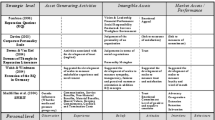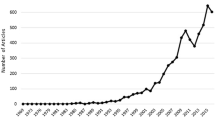Abstract
Different theoretical approaches highlight the growing relevance of corporate reputation as strategic factor. Among these approaches the arguments of the Resource-Based View are special worthwhile (Grant, 1991, California Management Review 33(3), 114–135; Barney, 1999, Sloan Management Review Spring, 137–145). Nevertheless, this topic poses several methodological problems (Barney et al., 2001), as the unavailability to identify and measure this organizational factor, that is “socially complex” and intangible in its nature. In this work, using the findings of our empirical research on Spanish biotechnology firms, we carry out an identification and measurement of corporate reputation, highlighting its two key components: “business reputation” and “social reputation”.
Similar content being viewed by others
References
R. Amit P. Schoemaker (1993) ArticleTitle‘Strategic Asset and Organizational Rents’ Strategic Management Journal 14 33–46
A. Arbelo P. Perez (2001) La Reputación como un Recurso Estratégico: un Enfoque de Recursos y Capacidades XI Congreso Nacional ACEDE Zaragoza
InstitutionalAuthorNameASEBIO (2002) Informe ASEBIO 2002 Associatión Española de Bioempresas Madrid
C. Baden-Fuller F. Ravazzolo T. Schweizer (2000) ArticleTitle‘Making and Meauring Reputations. The Research Ranking of European Business Schools’ Long Range Planning 33 621–650
J.B. Barney (1986) ArticleTitle‘Strategic Factor Markets: Expectations, Luck, and Business Strategy’ Management Science 32 IssueID10 1231–1241
J. B. Barney (1991) ArticleTitle‘Firms Resources and Sustained Competitive Advantage’ Journal of Management 17 IssueID1 99–120
J. B. Barney (1999) How a Firm’s Capabilities Affect Boundary Decisions Sloan Management Review Spring 137–145
J. B. Barney (2001) ArticleTitle‘Is the Resource-Based “View” a Useful Perspective for Strategic Management Research? Yes’ Academy of Management Review 26 IssueID1 41–56
B. Brown S. Perry (1994) ArticleTitle‘Removing the Financial Performance Halo from Fortune’s ’Most Admired Companies’ Academy of Management Journal 37 1346–1359
T. Brusch K. Artz (1999) ArticleTitle‘Toward a Contingent Resource-Based Theory: The Impact of Information Asymmetry on the Value of Capabilities in Veterinary Medicine’ Strategic Management Journal 20 223–250
D. Carolis ParticleDe (2002) ArticleTitle‘Competences and Imitability in the Pharmaceutical Industry: An Analysis of Their Relationship with Firm Performance’ Journal of Management 29 27–50
De Quevedo, E.: 2001, Reputación y Creación de Valor: Una Relación Circular. Aplicación al Sector Bancario Español, Tesis Doctoral, Universidad de Burgos
D. Deephouse (2000) ArticleTitle‘Media Reputation as a Strategic Resource: An Integration of Mass Communication and Resource-based Theories’ Journal of Management 26 IssueID6 1091–1112 Occurrence Handle10.1177/014920630002600602
I. Dierickx K. Cool (1989) ArticleTitle‘Asset Stock Accumulation and Sustainability of Competitive Advantage’ Management Science 35 IssueID12 1504–1513
W. Dillon N. Mulani D. Frederick (1984) ArticleTitle‘Removing Perceptual Distortions in Product Space Analysis’ Journal of Marketing Research 21 184–193
M. J. Dollinger P. Golden T. Saxton (1997) ArticleTitle‘The Effect of Reputation on the Decision to Joint Venture’ Strategic Management Journal 18 IssueID2 127–140 Occurrence Handle10.1002/(SICI)1097-0266(199702)18:2<127::AID-SMJ859>3.0.CO;2-H
C. Fombrun M. Shanley (1990) ArticleTitle‘What’s in a Name? Reputation Building and Corporate Strategy’ Academy of Management Journal 33 IssueID1 233–258
C.J. Fombrun (1996) Reputation. Realizing Value from the Corporate Image Harvard Business School Press Boston
Fombrun C. and C. Van Riel: 1997, The Reputational Landscape. Corporate Reputation Review 1(1)
R. Grant (1991) ArticleTitle‘The Resource-based Theory of Competitive Advantage: Implications for Strategy Formulation’ California Management Review 33 IssueID3 114–135
E. A. Groenland (2002) ArticleTitle‘Qualitative Research to Validate RQ-Dimensions’ Corporate Reputation Review 4 IssueID4 308–315
R. Hall (1992) ArticleTitle‘The Strategic Analysis of Intangible Resources’ Strategic Management Journal 13 135–144
J. B. Mcguire T. Schneeweis B. Branch (1990) ArticleTitle‘Perceptions of Firm Quality: A Cause o Result of Firm Performance’ Journal of Management 16 IssueID1 167–180
I. Nonaka H. Takeuchi (1995) The Knowledge Creating Company. How Japanese Companies Create the Dynamics of Innovation Oxford University Press London
M. Peteraf (1993) ArticleTitle‘The Cornerstones of Competitive Advantage: A Resource-Based View’ Strategic Management Journal 14 179–191
J. Petrick R. Scherer J. Brodzinski J. Quinn M. Ainina (1999) ArticleTitle‘Global Leardership Skills and Reputational Capital: Intangible Resources for Sustainable Competitive Advantage’ Academy of Management Executive 13 IssueID1 58–69
M. Porter (1980) Competitive Strategy Free Press New York
T. C. Powell A. Dent-Micallef (1997) ArticleTitle‘Information Technology as Competitive Advantage: The Role of Human, Business, and Technology Resources’ Strategic Management Journal 18 IssueID5 375–405 Occurrence Handle10.1002/(SICI)1097-0266(199705)18:5<375::AID-SMJ876>3.0.CO;2-7
H. Rao (1994) ArticleTitle‘The Social Construction of Reputation: Certification Contest, Legitimation, and Survival of Organizations in the American Automobile Industry: 1895–1912’ Strategic Management Journal 15 29–44
R. Reed R. J. Defillippi (1990) ArticleTitle‘Causal Amgiguity, Barriers to Imitation, and Sustainable Competitive Advantage’ Academy of Management Review 15 IssueID1 88–102
P. Roberts G. Dowling (2002) ArticleTitle‘Corporate Reputation and Sustained Superior Financial Performance’ Stratregic Management Journal 23 1077–1093
M. Rouse U. Daellenbach (1999) ArticleTitle‘Rethinking Research Methods for the Resource-Based Perspective: Isolating Sources of Sustainable Competitive Advantage’ Strategic Management Journal 20 IssueID5 487–494 Occurrence Handle10.1002/(SICI)1097-0266(199905)20:5<487::AID-SMJ26>3.0.CO;2-K
R. P. Rumelt (1991) ArticleTitle‘How Much Does Industry Matter?’ Strategic Management Journal 12 167–185
O. Shenkar E. Yuchtman-Yaar (1997) ArticleTitle‘Reputation, Image, Prestige, and Goodwill: An Interdisciplinary Approach to Organizational Standing’ Human Relations 50 IssueID11 1361–1381
S. Standifird (2001) ArticleTitle‘Reputation and E-commerce: eBay Auctions and the Asymmetrical Impact of Positive and Negative Ratings’ Journal of Management 27 279–295 Occurrence Handle10.1016/S0149-2063(01)00092-7
J. V. Vicente-Lorente (2001) ArticleTitle‘Specificity and Opacity as Resource-Based Determinants of Capital Structure: Evidence for Spanish Manufacturing Firms’ Strategic Management Journal 22 157–177 Occurrence Handle10.1002/1097-0266(200101)22:2<157::AID-SMJ152>3.0.CO;2-2
K. Weigelt C. Camerer (1988) ArticleTitle‘Reputation and Corporate Strategy: A Recent Theory and Applications’ Strategic Management Journal 9 443–454
B. Wernerfelt (1984) ArticleTitle‘A Resource-Based View of the Firm’ Strategic Management Journal 5 171–180
P. Yeoh K. Roth (1999) ArticleTitle‘An Empirical Analysis of Sustained Advantage in the U.S. Pharmaceutical Industry: Impact of Firm Resources and Capabilities’ Strategic Management Journal 20 637–653 Occurrence Handle10.1002/(SICI)1097-0266(199907)20:7<637::AID-SMJ42>3.0.CO;2-Z
Author information
Authors and Affiliations
Corresponding author
Additional information
Dr. Gregorio Martín de Castro is Assistant Professor at the Business Administration Department in Universidad Complutense de Madrid (Spain). He has several years of research experience at CIC Spanish Knowledge Society Research Centre, he holds an Expert Diploma in Intellectual Capital and Knowledge Management from INSEAD (France), and he was a Post-Doctoral Research Fellow at Harvard University during 2004–2005. He is author and co-author of several papers concerning Resource-Based View, Intellectual Capital and Knowledge Management.
Dr. José Emilio Navas López is Professor and Head of the Business Administration Department in Universidad Complutense de Madrid (Spain). He is author and co-author of several books and papers concerning Technology Management, Strategy and Knowledge Management. He has held the first Knowledge Management Chair in Spain at I.U. Euroforum Escorial.
Dr. Pedro López Sáez is Assistant Professor at the Business Administration Department in Universidad Complutense de Madrid (Spain) and he was a Research Fellow at Harvard University during 2004–2005. He has several years of research experience at CIC Spanish Knowledge Society Research Centre and he is author and co-author of several papers concerning Resource-Based View, Intellectual Capital and Knowledge Management.
Rights and permissions
About this article
Cite this article
de Castro, G.M., López, J.E.N. & Sáez, P.L. Business and Social Reputation: Exploring the Concept and Main Dimensions of Corporate Reputation. J Bus Ethics 63, 361–370 (2006). https://doi.org/10.1007/s10551-005-3244-z
Issue Date:
DOI: https://doi.org/10.1007/s10551-005-3244-z




